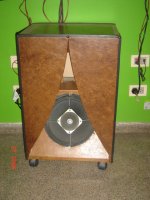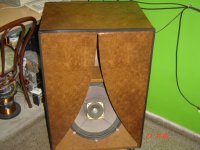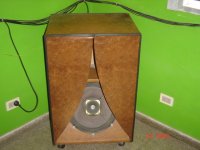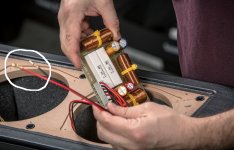I built DTQWT-12 a few years ago. It was a fun project. You are doing a great job, and you will really enjoy the sound. They are very musically satisfying.
Some very good sounding and very reliable EL34 tubes are the new production Gold Lion KT77.
One suggestion, the zinc speaker binding posts included with the Jantzen kit should be replaced by real copper or brass posts for an enormous improvement. Pot metal is not ideal for audio signal conductor. 😉
Rich
Some very good sounding and very reliable EL34 tubes are the new production Gold Lion KT77.
One suggestion, the zinc speaker binding posts included with the Jantzen kit should be replaced by real copper or brass posts for an enormous improvement. Pot metal is not ideal for audio signal conductor. 😉
Rich
Buen trabajo! Saludos desde Rosario 🙂
Hola y gracias amigo de los pagos de Olmedo.....no toca botón ! 😉
I built DTQWT-12 a few years ago. It was a fun project. You are doing a great job, and you will really enjoy the sound. They are very musically satisfying.
Thanks friend, 🙂 I'm really enjoying the fun, and the time will come the great revelation. I think for my room 2x10 inches would have been too, but I know that 2x15 inches are somewhat serious about bass extension. In an Australian forum one diyer friend told much the same and very satisfied, also is a musician, what (not always) gives authority to the comments he makes.
Some very good sounding and very reliable EL34 tubes are the new production Gold Lion KT77.
My current supply of pipes is:
KT-88 Shuguang (one failed, I re-soldered pins the suspect subject, but I'm afraid to try it, I do not want to damage my amplifier ), KT-88 Shuguang and EL-34 ex JJ Tesla. When I can, I'll go for something better. Thank you for the advice.
One suggestion, the zinc speaker binding posts included with the Jantzen kit should be replaced by real copper or brass posts for an enormous improvement. Pot metal is not ideal for audio signal conductor. 😉
Rich
Thanks again, but I am afraid that at this point the translator makes a trick .... ( and you may have noticed that my bad English, if there San Google I would not exist in this forum and other English-speaking)

He translated Zinc word, something very unlikely, I think you mean aluminum, this material seems to be the binding post photos from the Jantzen page....😕 ,for its opaque color.
I have received are chrome plated, you can see well in the first post of this thread. I think there will be no changes, you're pretty skeptical improvements cables, spikes, etc. Except low signal cables for phono, everything else is much Voodu for me...😱
Speaker cables except very thin and long, of course ..
Regards
Rolando
Rolando,.......
I have received are chrome plated, you can see well in the first post of this thread. I think there will be no changes, you're pretty skeptical improvements cables, spikes, etc. Except low signal cables for phono, everything else is much Voodu for me...😱
Speaker cables except very thin and long, of course ..
Regards
Rolando
As always, very cool advancings and eager to know the results!
I also consider probably low/none difference about changing connexions, as follow:
About the connectors and cables, I also consider too much voodoo in the very inflated cable world. Although I have perceived sometimes a betterment, this is comparing things like the most expensive Nordost vs one very el-cheapo PVC cables, in line level and speaker level, at same time, so I believe this becoming from the line level inter-connections (in phono level, with MM cartridges, the capacitance will make great changes with various cables brands; pure science).
But I prefer at least avoid the PVC since this destroy the cooper with time and is equivalent to bad caps (also one controversial point, but generally I prefer good dieletrics since sometimes I perceived some benefit). And I prefer very heavy shielded for unbalanced connections, for impressive low noise (at balanced line like levels). For speaker crossover wiring, one rigid cable makes more perfect wiring to the eyes.
But here goes to connectors... I consider them more important than cables, since connectors tarnish with time, and sometimes make bad contacts, with real multitude of interferences. I have measured in several cases more than 1% THD with a spray of harmonics in old vintage receivers/amplifiers not becoming from the amplifier, but from worn out sockets, fuses (when in series with audio output) and potentiometers. Add a high-Z connector in equation and we have noise, too.
I know some audio fellows with 15years+ cables, with notorious tarnishing/worn out contacts. No wonder they believe in magic cables 😉🙂
For connectors I prefer to match the female/male material (to avoid intermetal effects), and use decent semi-expensive brands (or at least the Amphenol top series), for maximum time with shinny clean low distortion and low impedance contacts.
And... sorry about being OT, but at least applies here in what we use to make our projects, like these one.
Last edited:
What a wonderful thing, loco!
I also have my 15" Karlsons home made several years ago.
Cordially Osvaldo.
I also have my 15" Karlsons home made several years ago.
Cordially Osvaldo.
Attachments
Last edited:
And... sorry about being OT, but at least applies here in what we use to make our projects, like these one.
Hi DIY BRAS 🙂
Many interesting points to answer, I like the OT that enrich and create healthy polemics .....
But I need some time for my limitations in the English language, I promise to respond promptly your comments and point by point.
Thanks for that.
Regards!
What a wonderful thing, loco!
I also have my 15" Karlsons home made several years ago.
Cordially Osvaldo.
Osvaldo hello 🙂
thanks for your comments, I also had cabinets Karlson, they look great! You could say something about the speaker you used? It is a montage of two conventional speakers in one, right? A coaxial made for yourself?
Greetings fellow!
Although I have perceived sometimes a betterment, this is comparing things like the most expensive Nordost vs one very el-cheapo PVC cables, in line level and speaker level, at same time, so I believe this becoming from the line level inter-connections (in phono level, with MM cartridges, the capacitance will make great changes with various cables brands; pure science).
Here we go.....:
First point, the comparison while changing cables line level and speaker is misleading to attribute the improvement which wire - if any -?
Second point, I agree that the optimal capacitance and impedance of phono input are affected by a bad cable, but, because only in MM? Moreover, I think it's much more important to a good cable if MC! Recall that the lower the input signal is more likely to affect it. Something very difficult in a connection of a CD player, with its typical 2.0 volts output ...
I continue, I must interrupt unfortunately, greetings !
................But I prefer at least avoid the PVC since this destroy the cooper with time
I had never heard that, I guess it will be a long time, but I did not get to see the deterioration ......🙄🙂
For speaker crossover wiring, one rigid cable makes more perfect wiring to the eyes.
I agree that it is important as it looks, I would have to align the red wires of my crossovers ....
 😀
😀But here goes to connectors... I consider them more important than cables, since connectors tarnish with time, and sometimes make bad contacts,
For connectors I prefer to match the female/male material (to avoid intermetal effects), and use decent semi-expensive brands (or at least the Amphenol top series), for maximum time with shinny clean low distortion and low impedance contacts.
You think it's better to solder crimp? I ask because if a big brand like Sonus Faber uses these simple connectors, metal against metal under pressure .....
Attachments
Rolando, great job, looking forward to seeing the finished speaker and your impressions. When changing your KT-88's, try KT-90, KT-120, or KT-150 (chequea que puede manejar tu amplificador). My experience has been an increase in bass reproduction (más real y controlado), and also better details, though dynamics vary.
Osvaldo hello 🙂
thanks for your comments, I also had cabinets Karlson, they look great! You could say something about the speaker you used? It is a montage of two conventional speakers in one, right? A coaxial made for yourself?
Greetings fellow!
Yesssssss‼
The bigger units are a 15" Sansui speakers re-enconed by a friend of the UTN who worked repairing them. Observe that the paper cone is original (From middle 70's), but the peripheral suspension is newer (10 years ago)
Tweeters are Jharo, 4" cone units.
The cabinets are more or less 12 years I made them.
No passive crossover, the separation is made in the pre-amplifier, at about 900Hz.
Osvaldo.
Rolando, great job, looking forward to seeing the finished speaker and your impressions. When changing your KT-88's, try KT-90, KT-120, or KT-150 (chequea que puede manejar tu amplificador). My experience has been an increase in bass reproduction (más real y controlado), and also better details, though dynamics vary.
Gracias amigo Guangui, creo que en unos pocos meses ya podre evaluar por fin el resultado, me he puesto como fecha limite Noviembre.
Me gusta el trabajo manual asi que realmente no estoy ansioso, lo disfruto y además quiero lograr un buen aspecto general de las cajas, por eso me demoro bastante en decidir algunos detalles. Por ejemplo, el cableado en el interior de la bocina a la vista no me agradaba mucho, pero son demasiados largos los recorridos si quiero evitar esto, a pesar que encontre una solucion haciendo una caladura en la garganta de la bocina, abandoné la idea porque ya estan muy pesados para moverlos dado el tamaño que tienen.
Mi intencion es que no queden los parlantes visibles, iran protegidos con un bastidor de malla metalicas y tela,extraíbles, tanto adelante como atras.
Espero que el sonido final sea lo que busco :
Graves profundos y rapidos, no retumbantes, medios claros y no fatigantes, agudos sin estridencias y con buena cantidad de armonicos, buena sensacion de profundidad, etc.
No estare pidiendo demasiado ?
Saludos !
Thanks friend Guanguí, I think in a few months and finally I be able to evaluate the result, I have become as November deadline.
I like manual work so I'm not really anxious, I enjoy it and also want to achieve a good overall appearance of the boxes, so I took a long to decide some details. For example, the wiring inside the horn in sight I did not like much, but too long journeys if I want to avoid this, although I found a solution by making a caladura in the throat of the horn, I abandoned the idea because they are already very heavy to move given the size they have.
My intention is that there are no visible speakers, iran protected with a metal frame and fabric mesh, removable, both front and back.
I hope the final sound is what I seek:
Deep bass and fast, not boomy, clear means and not fatiguing, treble without fanfare and with good amount of harmonics, good sense of depth, etc.
I will not be asking too much?
Regards !
Yesssssss‼
The bigger units are a 15" Sansui speakers re-enconed by a friend of the UTN who worked repairing them. Observe that the paper cone is original (From middle 70's), but the peripheral suspension is newer (10 years ago)
Tweeters are Jharo, 4" cone units.
The cabinets are more or less 12 years I made them.
No passive crossover, the separation is made in the pre-amplifier, at about 900Hz.
Osvaldo.
It is rare that such suspension has deteriorated, are like "oiled accordion". Which they deteriorate faster are the foam, although they can apply liquid silicone with a brush.
That gives them a few years of life, although in such cases hardens slightly altering the parameters of compliance.
But in a cabinet Karlson not affected, because they NOT need accurate tuning as a bass reflex.🙂
Regards !
Last edited:
OK. I'm very happy with this K's, not with the others, you know.
With only 12W per channel, all the house vibrates hardly.
With only 12W per channel, all the house vibrates hardly.
I like these levels of efficiency/sensitivity! 🙂OK. I'm very happy with this K's, not with the others, you know.
With only 12W per channel, all the house vibrates hardly.
If the terminal is from industrial types/models, with very good grip/contact pressure, is OK. I use sometimes, from a local electric products shop. Personally I prefer to solder, and when the project is "immovable"/fixed, I first assure metal to metal contact and then I apply solder.I had never heard that, I guess it will be a long time, but I did not get to see the deterioration ......🙄🙂
I agree that it is important as it looks, I would have to align the red wires of my crossovers ....😀
You think it's better to solder crimp? I ask because if a big brand like Sonus Faber uses these simple connectors, metal against metal under pressure .....
Karlson's cabinets are well recognized by this fact, they strongly increases radiation resistance.
Maybe not... 😀🙂......
Espero que el sonido final sea lo que busco :
Graves profundos y rapidos, no retumbantes, medios claros y no fatigantes, agudos sin estridencias y con buena cantidad de armonicos, buena sensacion de profundidad, etc.
No estare pidiendo demasiado ?
Saludos !
........
I hope the final sound is what I seek:
Deep bass and fast, not boomy, clear means and not fatiguing, treble without fanfare and with good amount of harmonics, good sense of depth, etc.
I will not be asking too much?
Regards !
Time to some additional notes, from my experience with my TQWT:
These TW034 tweeter or it's norwegian cousin are very well behaved and well integrated via waveguide to JA/HMQ8008, so they sound smooth without any hint of own harshness, but reveal most poor recordings.
All visitors have praise to this tweeter, saying things like "Oh, is impossible to find one defect in them" and so on. Of course not sound like ribbons, but I've compared them with my DIY plasma tweeter, and resembles very much the HF sound since both have almost zero energy storage in that area. But I prefer to use the lower attenuation in tweeter, and sometimes with zero ohm, when listening very off-axis (or with some amps/recordings on axis), to raise the power response and perceived HF at side listening.
I have found less sense of depth if compared to my now defunct OB (open baffle) project, but is good if paired with good amps, specially tubed ones.
Midrange is clean since the JA-8008 is very well behaved in this area, and bass is clean and fast.
So maybe you can expect great results but of course is taste-dependent.
Last edited:
- Home
- Loudspeakers
- Multi-Way
- DTQWTII from Argentina



